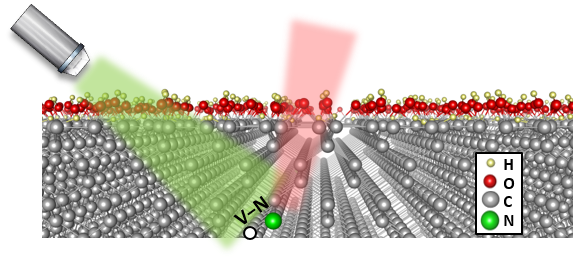Experts at HUN-REN Wigner Research Centre for Physics are developing a new generation quantum micro-scope in the framework of a recently launched project. The goal is to realize a device that physicists, chem-ists, biologists, and engineers can use as a quantum sensor to examine and characterize various materials with unprecedented spatial resolution and sensitivity.
The research group led by Ádám Gali uses the exquisite properties of diamond nitrogen vacancy center to measure magnetic, electric and mechanical fields or temperature with high spatial resolution.

The nitrogen vacancy center in the diamond acting as a quantum sensor detects the region above the dia-mond under suitable illumination (green light), which is detected optically (red light)
During the project, they plan to implement special measurement methods with the quantum microscope, such as magnetic resonance optical readout based on fluorescence lifetime, and fluorescence imaging based on two-photon absorption, which, according to their knowledge, would offer a unique tool to the technological market since diamond based quantum sensors combined with such components do not yet exist. The measurement technique based on single diamond nitrogen-vacancy centers, which is planned to be used in the quantum microscope, is also a unique solution in Europe.
The group plans to develop several types of microscopes, with a simpler and at the same time cheaper ver-sion they want to help the training of users, while a more complex type will be used in the laboratories of universities, research institutes, companies and factories to examine different materials. The big advantage of the devices is that they will work at room temperature, do not require special conditions and operate at low power.
The recently launched project led by Orsolya Kálmán and Zoltán Zimborás also serves the development of quantum technology. Their aim is to connect artificial intelligence and certain areas of quantum technology (for example, quantum computing and quantum sensing), and thus to develop a software package that uses machine learning and other artificial intelligence-based algorithms to make today's noisy quantum computers more efficient.
As part of the project, they also want to develop algorithms that utilize near-term quantum processors for machine learning and processing quantum sensor data. The primary goal is to develop an AI-assisted quantum gate compiler, which includes a quantum error mitigation procedure as well. In addition, as a test or as an industrial use-case, they plan to develop quantum machine learning algorithms that can be enhanced by the quantum hardware and the developed compilation and error mitigation tools. The mentioned algorithms will be tested both on classical simulators and on quantum processors.
Both projects will last until 2026, and according to the researchers, they will make a significant contribution to national and European quantum technology developments.



